It may sound silly discussing the right quantity of toothpaste (amidst all the worries on earth), but it absolutely makes sense both economically and biologically to get clarity on how much is enough? I often get questioned about the right brushing technique, the best toothpaste, ideal time to brush, importance of flossing and yet I chose to throw some light on the quantity of toothpaste! After all, it is a part of your daily regimen.
Conventionally, tooth powder was used but it was more abrasive in nature stripping away enamel with time. The first commercial paste was manufactured by Colgate in jars in 1870s. The most important ingredient, Fluoride, was added in paste in 1914 owing to its anti-cavity property. With time, sweeteners, detergent, flavoring, whitening and/or desensitizing agents were added to make the paste more palatable, less abrasive and overall enhance the brushing experience. Claude Hopkins (father of modern marketing) adopted famous habit loop campaign with Pepsodent Toothpaste in early 20th century and was responsible for inculcating daily brushing habit in Americans (jumping from 7% to 65% in less than a decade).
TOOTHPASTE REQUIREMENT
INFANTS
- 6 Months-1 year old: Start using soft clean cloth to wipe the baby’s mouth post feeding. Switch to wet finger brush WITHOUT toothpaste as soon as first tooth appears until one year of age.
- 1-2 Years: Rice grain size of non-fluoridated toothpaste as the child hasn’t developed swallowing reflex yet.
- 2-3 Years: Rice grain size of fluoridated toothpaste to provide essential minerals during tooth formation stage.
CHILDREN
Age group of 3-6 years can use HALF OF PEA size of fluoridated toothpaste.
ADULTS
Above 6 years of age, all that is needed is a PEA-SIZED BALL OF TOOTHPASTE to thoroughly clean your teeth. That’s right!
HARMFUL EFFECT OF EXCESSIVE TOOTHPASTE
FLUOROSIS: Extra precaution should be taken while supervising kids during brushing to ensure minimal amount of paste exposure and negligible swallowing of fluoridated toothpaste (flavored sugary paste is invariably gulped down by children). Excessive intake of fluoride may interfere with proper tooth formation resulting in structural defects with compromised appearance and strength. Fluorosis typically presents as spots, roughness or internal brownish discoloration on enamel. It can also have an impact on bone density of growing children.
If the child accidently swallows lot of paste, make him/her drink milk immediately which binds with excess fluoride and helps in flushing it out of the body.
While adults may not experience changes in enamel composition, you are certainly wasting a lot of money on this daily commodity. Excessive paste also results in a frothy mouth compelling early rinsing and compromised brushing. You cannot brush for two minutes with mouthful of froth covering all surfaces! The foam producing agent in toothpaste is a compound called sodium lauryl sulfate which causes skin irritation and may be responsible for canker sores in mouth.
Extra toothpaste is literally gone down the drain without having any impact on the health of your teeth.
A fully smeared swirl of toothpaste lining the whole length of toothbrush is sadly a marketing gimmick we all fall prey to!
BOTTOM LINE: Squeeze little paste from the bottom not fat blobs form the middle!
If you are on a lookout for healthy tips and tricks of maintaining oral health, follow us on Facebook and Instagram!







